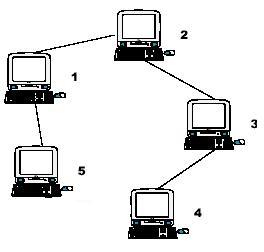Problem Description
A school bought the first computer some time ago(so this computer's id is 1). During the recent years the school bought N-1 new computers. Each new computer was connected to one of settled earlier. Managers of school are anxious about slow functioning of the net and want to know the maximum distance Si for which i-th computer needs to send signal (i.e. length of cable to the most distant computer). You need to provide this information.

Hint: the example input is corresponding to this graph. And from the graph, you can see that the computer 4 is farthest one from 1, so S1 = 3. Computer 4 and 5 are the farthest ones from 2, so S2 = 2. Computer 5 is the farthest one from 3, so S3 = 3. we also get S4 = 4, S5 = 4.

Hint: the example input is corresponding to this graph. And from the graph, you can see that the computer 4 is farthest one from 1, so S1 = 3. Computer 4 and 5 are the farthest ones from 2, so S2 = 2. Computer 5 is the farthest one from 3, so S3 = 3. we also get S4 = 4, S5 = 4.
Input
Input file contains multiple test cases.In each case there is natural number N (N<=10000) in the first line, followed by (N-1) lines with descriptions of computers. i-th line contains two natural numbers - number of computer, to which i-th computer is connected and length of cable used for connection. Total length of cable does not exceed 10^9. Numbers in lines of input are separated by a space.
Output
For each case output N lines. i-th line must contain number Si for i-th computer (1<=i<=N).
Sample Input
5 1 1 2 1 3 1 1 1
Sample Output
3 2 3 4 4
给出每台电脑的连接情况(和哪台电脑连和两台电脑之间的距离),求该图中离该电脑最远电脑的距离.如(输入1):第二台电脑和第一台电脑之间的距离为1,第三台电脑和第二台电脑之间的距离为1......
代码如下:
#include<stdio.h>
#include<cstring>
#include<queue>
#include<cmath>
#include<algorithm>
const int MAX=300300;
using namespace std;
int head[MAX];
bool vis[MAX];
int dis1[MAX],dis2[MAX];
int ans=0,pt;
int dist[MAX];
int edgenum;
struct node{
int from,to,val,next;
}edge[MAX*2];
void init()
{
memset(head,-1,sizeof(head));
edgenum=0;
}
void add(int u,int v,int w)
{
edge[edgenum].from=u;
edge[edgenum].to=v;
edge[edgenum].val=w;
edge[edgenum].next=head[u];
head[u]=edgenum++;
}
int bfs(int s)
{
memset(dist,0,sizeof(dist));
memset(vis,0,sizeof(vis));
queue<int>que;
que.push(s);
vis[s]=true;
dist[s]=0;
ans=0;
pt=s;
while(!que.empty())
{
int u=que.front();
que.pop();
for(int i=head[u];i!=-1;i=edge[i].next)
{
int v=edge[i].to;
if(!vis[v])
{
if(dist[v]<dist[u]+edge[i].val)
{
dist[v]=dist[u]+edge[i].val;
if(ans<dist[v])
{
ans=dist[v];
pt=v;
}
}
vis[v]=true;
que.push(v);
}
}
}
return pt;
}
int main()
{
int n,m,a,b,Q,W;
while(scanf("%d",&n) !=EOF)
{
init();
for(int i=2;i<=n;i++)
{
scanf("%d%d",&a,&b);
add(i,a,b);
add(a,i,b);
}
W=bfs(1);
Q=bfs(W);
for(int i=1;i<=n;i++)
dis1[i]=dist[i];
bfs(Q);
for(int i=1;i<=n;i++)
dis2[i]=dist[i];
for(int i=1;i<=n;i++)
{
printf("%d\n",max(dis1[i],dis2[i]));
}
}
return 0;
}























 134
134

 被折叠的 条评论
为什么被折叠?
被折叠的 条评论
为什么被折叠?








